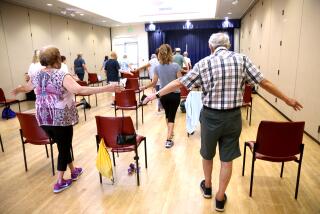Factors Seniors Should Consider When Buying a Car
- Share via
So much for the stereotype that older drivers keep their cars forever.
Nearly a third of consumers who bought new 1997 passenger cars were 55 or older, according to the American Automobile Manufacturers Assn.
And which models are on the top 10 list for older drivers?
“There’s no survey I know of,” says Jack Gillis, director of public affairs at the Consumer Federation of America, a nonprofit organization based in Washington.
“But there are key vehicles that tend to appeal to older drivers. In terms of popularity, there seems to be a correlation between size and seniority,” says Gillis, author of “The Car Book 1998” (HarperCollins Publishers, $13.95), an annual buying guide.
Current and recent models that have proved popular with senior drivers, Gillis says, include the Ford Crown Victoria, the Lincoln Town Car and the Chevrolet Caprice: “Those are the cars that give a smoother ride, more insulation from the outside environment, both psychologically and physically. And one of the things about these cars is that they haven’t changed much over the years.”
Whether seeking their dream car or simple transportation, older buyers should consider the value of certain features and the drawbacks of others, say physical therapists, back specialists and safety experts. That’s true whether you have arthritis, orthopedic problems, a history of back trouble--or just a strong desire to avoid accidents and celebrate the century mark.
To start, the 55-plus consumer interested in buying the safest car possible should choose a full-size vehicle, says Chuck Hurley, executive director of public affairs for the National Safety Council. “A small car doubles the risk of fatality over a large car,” he says.
For safety, cars should also have air bags and a good safety-belt system. Among the makes that meet these criteria, Hurley says, are Buicks, Volvos and Infinitis.
*
Once you’ve narrowed the field to specific models, you can evaluate the pros and cons of specific features, depending on your age and any health-related conditions:
* Consider “step-in” height. That’s the advice of Robert Barnett, a consulting physical therapist at Mt. San Antonio Gardens, a seniors community in Claremont. “A small, short person--say, under 5-4--would probably not be a candidate for a sport-utility vehicle, for instance,” he says.
* Check out doors and seats. In general, “four doors are preferable to two for older people,” Barnett says, “because of the ease of entry in and out of the back seat.”
Bench or bucket seats? That’s a more difficult question. Bench seats are easier to get in and out of, but bucket seats provide more stability, experts say.
* Evaluate visibility. When sitting in the car, can you see over the hood? Can you easily use the side-view mirrors? “Most of us lose mobility in our spine and neck as we age,” Barnett says, “so it’s not as easy to check blind spots. Older people rely more on mirrors. It’s good to have remote-control mirrors.”
* Evaluate ease of entry and exit. Buyers with back problems should be sure the car seat fits them comfortably or can be adjusted to fit, says Annette Swezey, a health educator at Swezey Institute in Santa Monica, where she and husband Dr. Robert Swezey specialize in the care of back patients. Get in and out several times, she suggests, to be sure you can do so without twisting the back. Be sure you can reach the dashboard and controls without straining the back too.
“If you can push the steering wheel out of the way, that’s even better,” she says. In general, “sport-utility vehicles are hard to get in and out of for those with back problems.”
* Choose automatic transmission. This is especially important if you already have orthopedic problems or if you anticipate knee surgery.
* Check out the trunk. Take a look at the height and size of the car’s trunk. Are you able to lift heavy objects over the trunk lip? A lower lift-over height on the trunk is desirable, Barnett says. Older buyers, in planning ahead, might want to consider whether the trunk is large enough for a wheelchair or walker.
* Adjust for arthritis. Consider a number of special features if you have arthritis, experts at the Arthritis Foundation suggest. Among them: cushioned seat belts to minimize shoulder discomfort; power steering, brakes and windows; a tilted steering wheel; and ignition controls that are easy to reach.
* Choose air bags. Don’t be afraid to use air bags, Hurley says. Just be sure you don’t sit too close to the steering wheel. Allow 10 inches from the center of the wheel to your chestbone and be sure to wear your seat belt. Considering models with side-impact panels or side air bags is a good idea too, Hurley says, because “older drivers tend to be involved in more intersection crashes than do younger drivers.”
* Consider anti-lock brakes. “Older drivers are more likely to find themselves in a situation where they slam on the brakes,” says Gillis of the Consumer Federation of America. “And it’s more difficult to control the car without anti-lock brakes because reaction times are slower.”
*
Frequent Times contributor Kathleen Doheny can be reached at kdoheny@compuserve.com.






